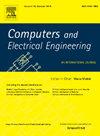A distributed end-to-end fair bandwidth allocation algorithm for multi-path networks
IF 4
3区 计算机科学
Q1 COMPUTER SCIENCE, HARDWARE & ARCHITECTURE
引用次数: 0
Abstract
Multi-path transmission significantly improves network performance, yet it complicates the problem of fair resource allocation. While traditional fair bandwidth allocation schemes thrive in single-path settings, they often falter when applied to multi-path environments, highlighting the challenge of achieving fair bandwidth sharing in such networks. To tackle this issue, the concept of "max-min similarity" of queuing delays has been introduced based on insight into the intrinsic interactions between queuing packets, delays, and bandwidth allocation, which leads to a formal definition of max-min fair bandwidth allocation for multi-path environments. Theoretical analysis shows that the max-min similarity of queuing delays is a sufficient condition for max-min fair bandwidth allocation in single bottleneck environments. A novel distributed end-to-end fair bandwidth allocation algorithm, named DMFBA, is then proposed, which separates the control into flow-level and transmission path-level. In achieving max-min similarity in queuing delays by dynamically adjusting the distribution of flows’ queuing packet quotas across paths it achieves the goal of max-min fair bandwidth allocation. Two sets of numerical simulation experiments were conducted and the results show that DMFBA has less overhead and faster convergence than the traditional utility fair algorithms.
多路径网络的分布式端到端公平带宽分配算法
多路径传输大大提高了网络性能,但也使公平资源分配问题变得更加复杂。传统的公平带宽分配方案在单路径环境中表现出色,但应用于多路径环境时往往会出现问题,这凸显了在此类网络中实现公平带宽共享所面临的挑战。为了解决这个问题,我们基于对队列数据包、延迟和带宽分配之间内在相互作用的洞察,引入了队列延迟的 "最大最小相似性 "概念,从而为多路径环境下的最大最小公平带宽分配下了一个正式定义。理论分析表明,队列延迟的最大最小相似性是单瓶颈环境下最大最小公平带宽分配的充分条件。随后提出了一种名为 DMFBA 的新型分布式端到端公平带宽分配算法,该算法将控制分为流量级和传输路径级。通过动态调整不同路径上流量队列包配额的分布,实现队列延迟的最大最小相似性,从而达到最大最小公平带宽分配的目标。我们进行了两组数值模拟实验,结果表明,与传统的实用公平算法相比,DMFBA 的开销更小,收敛速度更快。
本文章由计算机程序翻译,如有差异,请以英文原文为准。
求助全文
约1分钟内获得全文
求助全文
来源期刊

Computers & Electrical Engineering
工程技术-工程:电子与电气
CiteScore
9.20
自引率
7.00%
发文量
661
审稿时长
47 days
期刊介绍:
The impact of computers has nowhere been more revolutionary than in electrical engineering. The design, analysis, and operation of electrical and electronic systems are now dominated by computers, a transformation that has been motivated by the natural ease of interface between computers and electrical systems, and the promise of spectacular improvements in speed and efficiency.
Published since 1973, Computers & Electrical Engineering provides rapid publication of topical research into the integration of computer technology and computational techniques with electrical and electronic systems. The journal publishes papers featuring novel implementations of computers and computational techniques in areas like signal and image processing, high-performance computing, parallel processing, and communications. Special attention will be paid to papers describing innovative architectures, algorithms, and software tools.
 求助内容:
求助内容: 应助结果提醒方式:
应助结果提醒方式:


